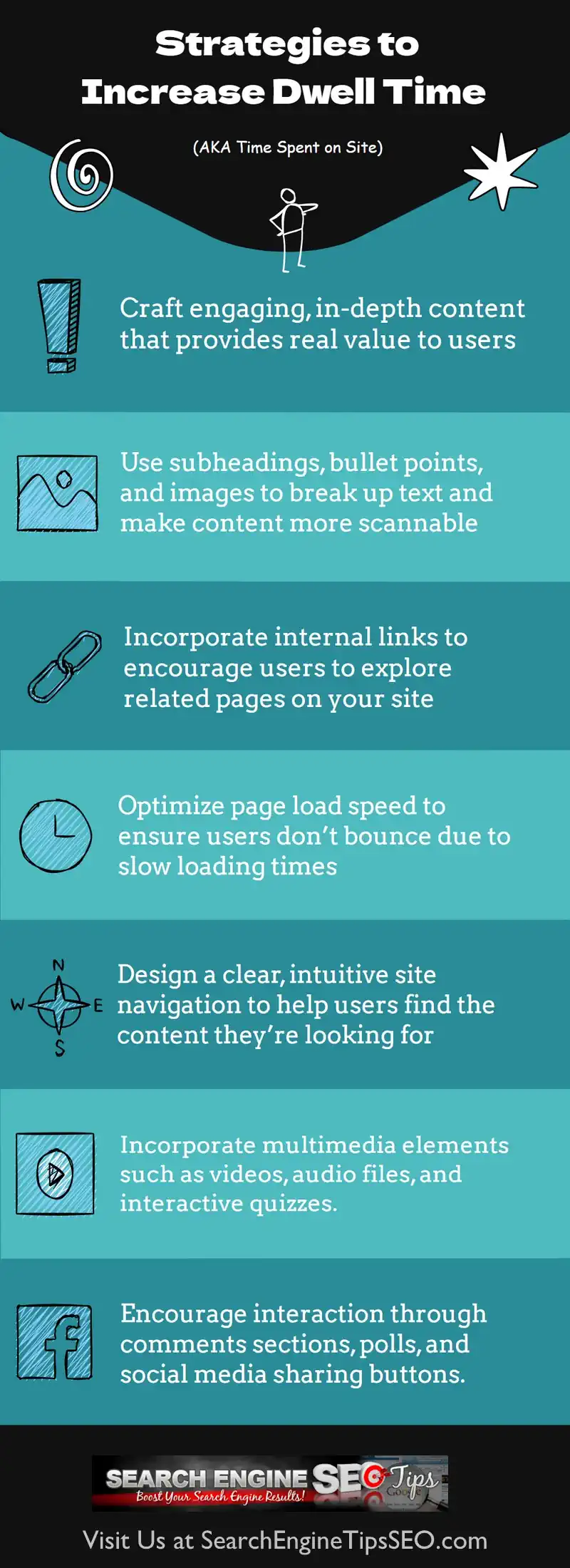Improving dwell time is vital for achieving higher rankings. Longer dwell times indicate quality and relevance, boosting your visibility in search results. Search engines prioritize user experience, making engagement metrics like dwell time essential. Factors like content relevance, site design, and loading speed influence dwell time. Analyzing metrics such as session duration and bounce rate helps enhance user experience.

To enhance dwell time, focus on fast loading speeds, clear navigation, and engaging content. Encourage interaction to keep users engaged. Understanding and optimizing dwell time can greatly impact your SEO success. Uncover more insights into maximizing your site’s potential.
Understanding Dwell Time
Dwell time refers to the duration of user visits to individual pages within a site, after clicking on a search result before returning to the search results page. In other words, the amount of time they spend on your site.
This metric is vital as it indicates how engaging and relevant your content is to users. By analyzing dwell time, you can gain insights into which pages are resonating with your audience and which ones might need improvement.
Dwell Time and SEO
As an SEO professional, you’re always looking for ways to improve your website’s rankings and drive more organic traffic. While there are countless factors that influence search engine rankings, dwell time is one metric that’s often overlooked. However, recent evidence suggests that dwell time is becoming a crucial component in determining website quality and search engine rankings.
Google’s patent, “Scoring site quality” (US9195944B1), reveals that the search giant is using dwell time as a key factor in evaluating the overall quality of a website. By measuring how much time users spend on a site, Google can infer the site’s relevance, usefulness, and engagement.
From an SEO perspective, this is a game-changer. No longer is it enough to optimize individual pages for specific keywords. Instead, the focus should be on creating a high-quality, engaging site that keeps users on the page for longer periods. The longer users dwell on your site, the more likely it is that Google will view your site as valuable and relevant, leading to higher rankings and more organic traffic.
When visitors spend more time on your site, it indicates that they find your content valuable and engaging. This positive user experience can lead to higher rankings because search engines aim to deliver the best possible results to users.
So how can you optimize for dwell time? The key is to create compelling, informative content that captures users’ attention and encourages them to explore your site further. This means going beyond simple keyword optimization and focusing on factors like content quality, site structure, and user experience.

Factors Influencing Dwell Time
Understanding the key elements that impact dwell time can greatly enhance your website’s performance and user engagement metrics.
Factors influencing dwell time include:
- The relevance of your content to the user’s search query
- The quality of your website’s design and user experience
- The loading speed of your pages
- The overall value provided to visitors
Engaging visuals, clear navigation, and compelling calls to action can also contribute to longer dwell times.
Analyzing Dwell Time Metrics
By analyzing dwell time metrics, you can gain valuable insights into user engagement and site performance.
- Average Session Duration: Understand how long users typically spend on your site
- Bounce Rate: Determine the percentage of visitors who navigate away from your site after viewing only one page
- Page Views per Session: Measure the number of pages a user views during a single visit
- Exit Pages: Identify which pages users are most likely to exit your site from
Analyzing these metrics can help you pinpoint areas for improvement, optimize content, and enhance user experience to increase dwell time and ultimately boost your site’s rankings.

Using Google to Track Dwell Time
In Google Analytics, you can find metrics related to dwell time under the “Audience” and “Behavior” sections. However, Google Analytics doesn’t explicitly use the term “dwell time.” Instead, you’ll want to look for the following metrics:
- Avg. Time on Page: This metric is found under “Behavior” > “Site Content” > “All Pages.” It represents the average amount of time users spend on individual pages of your website.
- Session Duration: Located under “Audience” > “Overview,” this metric shows the average time users spend on your website during a single visit, across all pages they view.
- Bounce Rate: Found under “Audience” > “Overview,” bounce rate is the percentage of single-page visits (i.e., visits in which the user leaves your site from the entrance page without interacting with the page or visiting any other pages).
In Google Search Console (GSC), you won’t find direct measurements of dwell time. However, you can find click-through rate (CTR) data, which is related to dwell time and user engagement:
- Click-through rate (CTR): Under “Performance” > “Search results,” you can see the CTR for your website’s pages in search results. A higher CTR can indicate that your page titles and meta descriptions are compelling and relevant to users, which may lead to longer dwell times, as long as the content of those pages is also relevant.
While these metrics can provide insights into user engagement and dwell time, it’s important to remember that they are not direct measurements of dwell time itself. To get a more comprehensive understanding of user engagement on your website, it’s best to analyze a combination of these metrics and look for patterns or trends over time.
Strategies to Increase Dwell Time Include:
- Crafting engaging, in-depth content that provides real value to users
- Using subheadings, bullet points, and images to break up text and make content more scannable
- Incorporating internal links to encourage users to explore related pages on your site
- Optimizing page load speed to ensure users don’t bounce due to slow loading times
- Designing a clear, intuitive site navigation to help users find the content they’re looking for
- Incorporate multimedia elements such as videos, audio files, and interactive quizzes.
- Encourage interaction through comments sections, polls, and social media sharing buttons.
By continuously monitoring and analyzing user behavior on your site, you can make data-driven decisions to further improve dwell time and overall user engagement.

By implementing these strategies and focusing on dwell time as a key SEO metric, you can improve your site’s overall quality score and potentially see a significant boost in your search engine rankings.
Future of Dwell Time in SEO
To stay ahead in the ever-evolving SEO landscape, it’s crucial to focus on and optimize for user engagement metrics, particularly dwell time. As search engine algorithms increasingly prioritize delivering the most relevant and valuable content to users, ensuring your content captures and retains visitor attention will be key to improving your search result rankings. Pay attention to this trend and act accordingly to remain competitive.
It’s worth noting that dwell time is just one of many factors that influence search rankings. Other important factors include backlinks, site authority, and content relevance. However, as Google’s patent suggests, dwell time is becoming an increasingly important metric in determining site quality and rankings.
Moving Forward
In today’s competitive SEO landscape, optimizing for dwell time is no longer optional – it’s essential for improving website visibility and attracting organic traffic. Websites that can keep users engaged and on their pages longer are likely to see higher rankings and increased organic traffic.
So start focusing on dwell time today, and watch as your rankings and organic traffic soar to new heights.

